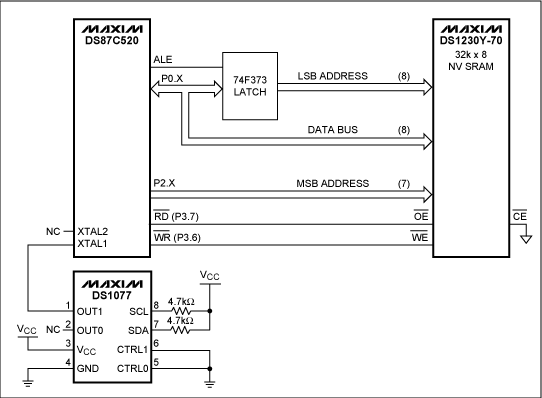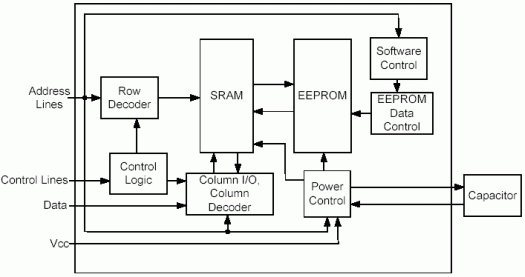Abstract: Dallas Semiconductor manufactures several EconOscillators? (DS1065, DS1077/DS1077L, DS1085/DS1085L, and DS1086). Since many of the features of these devices cannot easily be categorized into fields in the on-line parametric database, the intent of this application note is to show a side-by-side comparison of members of the EconOscillator family and to eliminate the hassles of sifting through numerous data sheets when trying to select a device.
Table 1. Device comparison
Note: Device specifications have been provided here for device comparison. In the case of discrepancy between this application note and the data sheet, the data sheet supersedes this application note.
Table 2. Frequency programming options
Table 3. Master oscillator frequency programming options
Application Notes for EconOscillators can be found at http://www.maxim-ic.com/appnotes10.cfm/ac_pk/10.
For ordering information, refer to the online ordering information.
Device Comparison
Dallas Semiconductor has EconOscillators for 3.3V, 5.0V, commercial, and industrial temperature applications. The package types vary between devices, though many EconOscillators are available in μSOP, SO, or DIP packages. The output frequencies vary between devices from 4.1kHz to 133MHz. Each device is described below and key features are compared in Table 1.DS1065
The DS1065 is an excellent choice when the application only requires a simple oscillator. This is the only EconOscillator in a space-saving 3-pin TO-92 package. The DS1065 is a 5V device that provides a single square wave output with a frequency range of 30kHz to 100MHz. There are 4 versions (dash numbers) of the DS1065. Each version has a different fixed master oscillator frequency: 60MHz, 66.667MHz, 80MHz, and 100MHz. Each master oscillator frequency can be divided down using the programmable divider. The DS1065 is programmable by a 1-Wire? interface. To program the device, the power has to be cycled; therefore it is not on-the-fly programmable.DS1077/DS1077L
The DS1077 is a 5V device, and the DS1077L is a 3.3V device. These devices provide a greater range of output frequencies on the dual outputs than the DS1065 (8.1kHz to 133MHz for the DS1077 or 4.87kHz to 66.66MHz for the DS1077L). There are 5 versions of the DS1077. Each version has a different fixed master oscillator frequency: 66MHz, 100MHz, 120MHz, 125MHz, and 133MHz. The DS1077L has 4 versions. Each version also has a different fixed master oscillator frequency: 40MHz, 50MHz, 60MHz, and 66.66MHz. Each master oscillator frequency can be divided down using the 2-wire programmable divider before being routed to the two output pins. The second output has an additional divider to generate even smaller frequencies. Power-down and output-enable modes are also available.DS1085/DS1085L
These devices also have a 5V version (DS1085) and a 3.3V version (DS1085L). The DS1085 outputs frequencies from 8.1kHz to 133MHz, and the DS1085L outputs frequencies from 4.1kHz to 66.66MHz. The DS1085/DS1085L also have a 2-wire interface allowing the device to be programmed in-circuit. The user has the ability to trim the master oscillator frequency from 66MHz to 133MHz in 10kHz, 25kHz, or 50kHz steps (dash numbers) for the DS1085 and from 33MHz to 66MHz in 5kHz, 12.5kHz, or 25kHz steps (dash numbers) for the DS1085L. Each master oscillator frequency can then be divided down using the programmable divider before being routed to the two output pins. The second output has an additional divider to generator even smaller frequencies. The DS1085/DS1085L also have power-down and output-enable modes.DS1086
The DS1086 is a stripped-down version of the DS1085 with the addition of a spread-spectrum output. The DS1086 operates from a 5V supply and provides a single output with frequencies from 260kHz to 133MHz. The master oscillator frequency of the DS1086 can also be trimmed from 66MHz to 133MHz in 10kHz steps. The master oscillator frequency can then be divided down using the 2-wire programmable divider before being routed to the output pin. The DS1086 has a dither output that can be enabled to reduce radiated emission peaks by dithering the output frequency. The user can choose either 2% or 4% dither. The DS1086 also has power-down and output-enable pins.Table 1. Device comparison
| DS1065 | DS1077 | DS1077L | DS1085 | DS1085L | DS1086 | |
| VCC | 5V | 5V | 3.3V | 5V | 3.3V | 5V |
| Package | 3 pin TO-92 | 8 pin SO, or μSOP | 8 pin SO, or μSOP | 8 pin SO | 8 pin SO | 8 pin SO, or 8 pin μSOP |
| Output Frequency | 30kHz–100MHz | 8.1kHz–133MHz | 4.87kHz–66.6MHz | 8.1kHz–133MHz | 4.1kHz–66MHz | 260kHz–133MHz |
| Frequency Tolerance | ±3.0% | ±1.0% | ±1.25% | ±1.0% | ±1.5% | ±1.0% |
| Power-down Modes | No | Yes | Yes | Yes | Yes | Yes |
| Active Supply Current (frequency dependent) | 50mA | 50mA | 30mA | 50mA | 15mA | 35mA |
| Number of Oscillator Outputs | 1 | 2 | 2 | 2 | 2 | 1 |
| Interface | 1-Wire | 2-Wire | 2-Wire | 2-Wire | 2-Wire | 2-Wire |
| Spread Spectrum Output | No | No | No | No | No | Yes |
| Crystal Reference | No | No | No | No | No | No |
Programming EconOscillators
Some of the EconOscillators offer more control over the master and output frequencies than other EconOscillators. All EconOscillators have a prescaler or divider to divide the master frequency into smaller frequencies (see Table 2). The DS1085, DS1085L, and DS1086 have even more control over the oscillator frequency with the ability to trim the master oscillator frequency (see Table 3).Table 2. Frequency programming options
| DS1065 | DS1077 | DS1077L | DS1085 | DS1085L | DS1086 | |
| Prescaler Divider | 1, 2, or 4 | 1, 2, 4, or 8 | 1, 2, 4, or 8 | 1, 2, 4, or 8 | 1, 2, 4, or 8 | 1, 2, 4,...256 |
| Divisor (N) | 2-513 | 2-1025 | 2-1025 | 2-1025 | 2-1025 | None |
Table 3. Master oscillator frequency programming options
| DS1085 | DS1085L | DS1086 | |
| Master Oscillator Frequency Range | 66MHz–133MHz | 33MHz–66MHz | 66MHz–133MHz |
| Step Size | 10kHz, 25kHz, or 50kHz | 5kHz, 12.5kHz, or 25kHz | 10kHz |
Conclusion
This application note compares Dallas Semiconductor's EconOscillators to assist customers in choosing the correct device for their application. This comparison will prevent customers from sifting through multiple data sheets and the on-line parameter database. For further information contact Applications Support at MixedSignal.Apps@dalsemi.com.Further Reading
Refer to the links below for the EconOscillator data sheets.Application Notes for EconOscillators can be found at http://www.maxim-ic.com/appnotes10.cfm/ac_pk/10.
For ordering information, refer to the online ordering information.
1-Wire is a registered trademark of Maxim Integrated Products, Inc.
EconOscillator is a trademark of Maxim Integrated Products, Inc.
 電子發燒友App
電子發燒友App






























評論